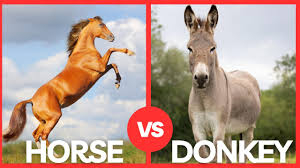Donkeys and horses, two iconic equines that have captivated humans for centuries, share a fascinating evolutionary history. While they originated from a common ancestor approximately 10 million years ago, they have since diverged into distinct species with unique characteristics and adaptations.
One of the most striking differences between donkeys and horses is their physical attributes, which are shaped by their environments. Donkeys, originating in warmer regions such as Africa, have developed larger ears than horses. These larger ears serve a crucial function in regulating body temperature, allowing donkeys to dissipate heat more efficiently in hot climates. Additionally, donkeys typically have thinner manes, tufted tails, and less water-resistant coats, all adaptations suited for warmer environments. While donkeys are well-adapted to regions like Africa, they can also be found in other parts of the world such as Asia, Europe, and the Americas.
On the other hand, horses, descendants of the wild Przewalski's horse and domesticated horses, are better suited for cooler temperate regions. Their comparatively smaller ears help minimize heat loss in colder climates. Horses often sport thicker manes, flowing tails, and more water-resistant coats, which provide insulation and protection against harsh weather conditions. These adaptations allow horses to thrive in regions with colder temperatures, such as Europe, North America, and parts of Asia.
Beyond physical characteristics, donkeys and horses also exhibit differences in behavior and temperament. Donkeys, known for their stoic nature, are less likely to flee when faced with danger compared to horses. This innate trait has earned them a reputation for being more stubborn or resistant to panic, making them valuable companions in challenging terrain. In contrast, horses are more easily spooked and rely heavily on their flight response to evade threats. This flight mechanism has been crucial for their survival in the wild, allowing them to quickly escape predators.
Furthermore, donkeys and horses have distinct roles in human history and culture. Donkeys have been used for centuries as reliable pack animals, capable of carrying heavy loads across rugged terrain. Their strength and endurance make them indispensable partners in agriculture and transportation, particularly in regions with challenging landscapes. Horses, on the other hand, have been prized for their speed, agility, and grace. From ancient cavalry units to modern-day racing competitions, horses have played diverse roles in warfare, sports, and leisure activities, cementing their status as beloved companions and symbols of power and nobility.
While donkeys and horses share a common ancestry, their evolutionary paths have led them to diverge into distinct species with unique adaptations and traits. Donkeys are the product of Equus africanus and Equus asinus, while horses are the progeny of Equus ferus and Equus caballus. From their physical attributes to their behavior and cultural significance, donkeys and horses embody the rich tapestry of biodiversity and human-animal relationships.
